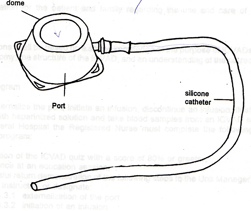Port-A-Cath
Description
The Port-A-Cath consists of two main components:
• A self-sealing septum encased in a port made of stainless steel, titanium or plastic, attached to
• A silicone catheter

Implanted ports are surgically inserted. The catheter tip is introduced in the vein (usually the cephalic, external jugular or subclavian vein) and advanced to the opening of the right atrium or just above in the SVC.
A subcutaneous pocket (usually in the anterior chest wall) is created to house the portal device. The catheter is tunneled from the insertion site to the subcutaneous pocket, where it is attached to the port. The port is stabilized with sutures to the fascia of the underlying muscle and the pocket is sutured closed.

The Port-A-Cath may have a single or double lumen. The lumens are attached at the port, and each has its own septum, which can be palpated through the subcutaneous tissue.